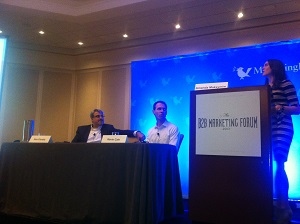What is influencer marketing, how do you measure it and where it does fit into a marketing strategy? These questions, along with many more, were put on the table in this afternoon’s session at the MarketingProfs B2B Marketing Forum. Led by Amanda Maksymiw of Lattice Engines, the panel under her control is the savvy tandem of Sam Fiorella & Kevin Cain.
Makysmiw starts the session by instating one of the cruelest rules a moderator can impose on a panel (and most enjoyable for the audience): all questions must be answered as posed. No hybrid answers and no middle of the road positions. Actual answers with a definitive stamp.
Thanks to Maksymiw’s rule, the session proves to be a fun, lively discussion that helped demystify the ever growing practice of influencer marketing.
Let’s dive in to ‘8 Influencer Marketing Questions’:
1) What is Influencer Marketing?
Amanda: I’ll start with the first answer. It is finding and building relationships with those who hold sway with your target audience.
Sam: The ability to sway the purchasing decisions of your target audience. The distinction is that influencers must be able to impact purchasing decisions.
2) What Comes First, Influencer Marketing or Content Marketing?
Kevin: Content comes first. It’s often the base or the starting point to reaching out to influencers.
Sam: Influence should be first. If you’re identifying influencers correctly, you can develop an understanding of the customer lifecycle – as well as those who impact their journey throughout. Therefore influencer marketing can define the content that is subsequently developed.
Kevin: I would disagree in that content marketing needs to consider customer lifecycle as well, so you can pinpoint content opportunities without starting with influencer marketing.
3) How Do You Identify Influencers?
Sam: You have to first understand that their are 2 different types of influencers:
1) Macro influencer- Reach a large audience and can influence or sway decisions.
2) Micro influencer- They may not have a large following or audience, but they are the people that are talking with your audience at the point of purchasing decisions.
Kevin: We look to what’s happening within our industry and use old-fashioned manual research to locate who is demonstrating influence within the industry.
4) How Do You Get Their Attention?
Kevin: Start by making sure the influencers know you exist. At Openview we lead with who we are as a brand and follow with what’s it in it for them (e.g. ). We also are firm believers of making participation easy for our influencers.
Sam: We are all motivated by something. To be successful, you have to understand what motivates your influencers. Know their audience and decipher what is it of value to them.
4) What If You’re Not A Big Brand With A Powerful Network?
Kevin: This can be a challenge. It still comes back to what’s in it for them? While you may not have a large network, can you demonstrate that you share a common audience or develop a proofpoint on how your brand can benefit their audience?
5) How Do You Locate Reactionary Content Opportunities?
Sam: First, you need to know your lifecycle and identify the archetypes or personas that make up your buying audience. Second, locate and listen to these individuals to locate what challenges they face and factors motivate them. These bits of information reveal the information you need to provide help nurture their customer journey.
6) How Much Of A Role Does Social Play in Influence?
Sam: I want to start by saying that social is important. B2B or B2c. It’s important. In terms of social as a tool, there’s value in looking at tools like Klout and Kred. The catch is you can’t look at these scores – which is a metric to demonstrate their reach – without the context of ‘who’ makes up their audience.
Kevin: For example, Justin Bieber is incredibly influential according to Klout, but he doesn’t sway my target audience.
Sam: Right. Don’t base an influence marketing strategy on the influencer. Base it on the customer. Meaning, if you care about your customer and look for those they value, you’ll naturally find those who influence their decisions.
7) How Do You Measure Influence?
Kevin: From my perspective, it’s pretty simple. Are other people creating our content? Are other people amplifying our content? If our plan is working, we should see gains in those areas.
Sam: The direct impact on the customer lifetime value (CLV).
8) Build the Brand or Driving Sales? What’s More Important in Influencer Marketing?
Kevin: Both are important, but forced to choose, I would say branding.
Sam: I would say sales. What’s the value of the brand if they don’t have sales. In an even more basic sense, a brand can’t exist without sales.
Maybe the most important take-away marketers can take from this session is that there doesn’t need to be a universal agreement on influencer marketing. What you do need is an understanding of who makes up your audience, what is their buying lifecycle and who can influence them along the way. If you build a plan with this foundational information, you can call it whatever you like…but you can definitely call it results.



